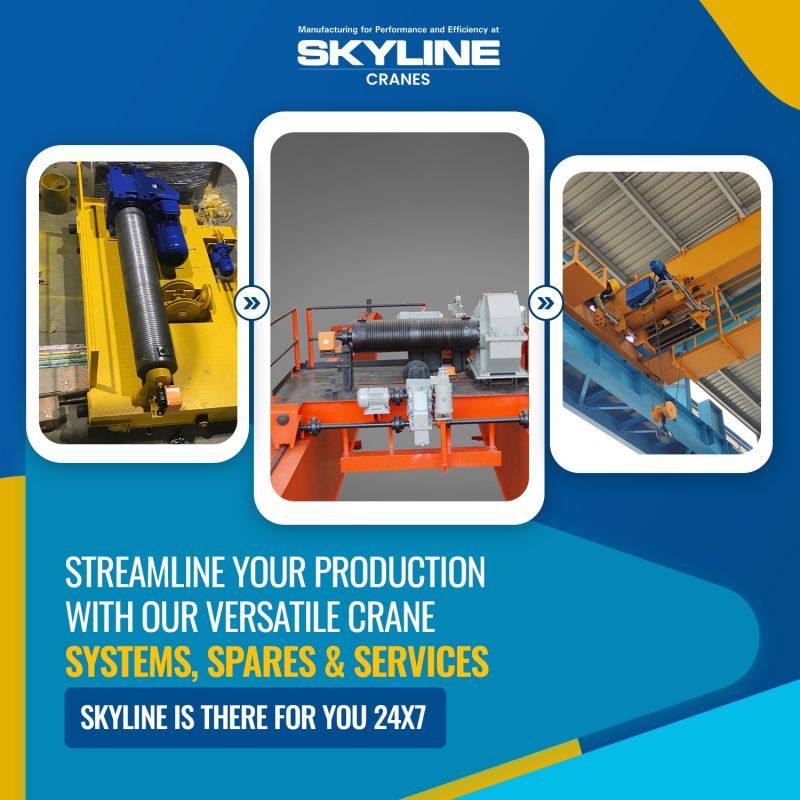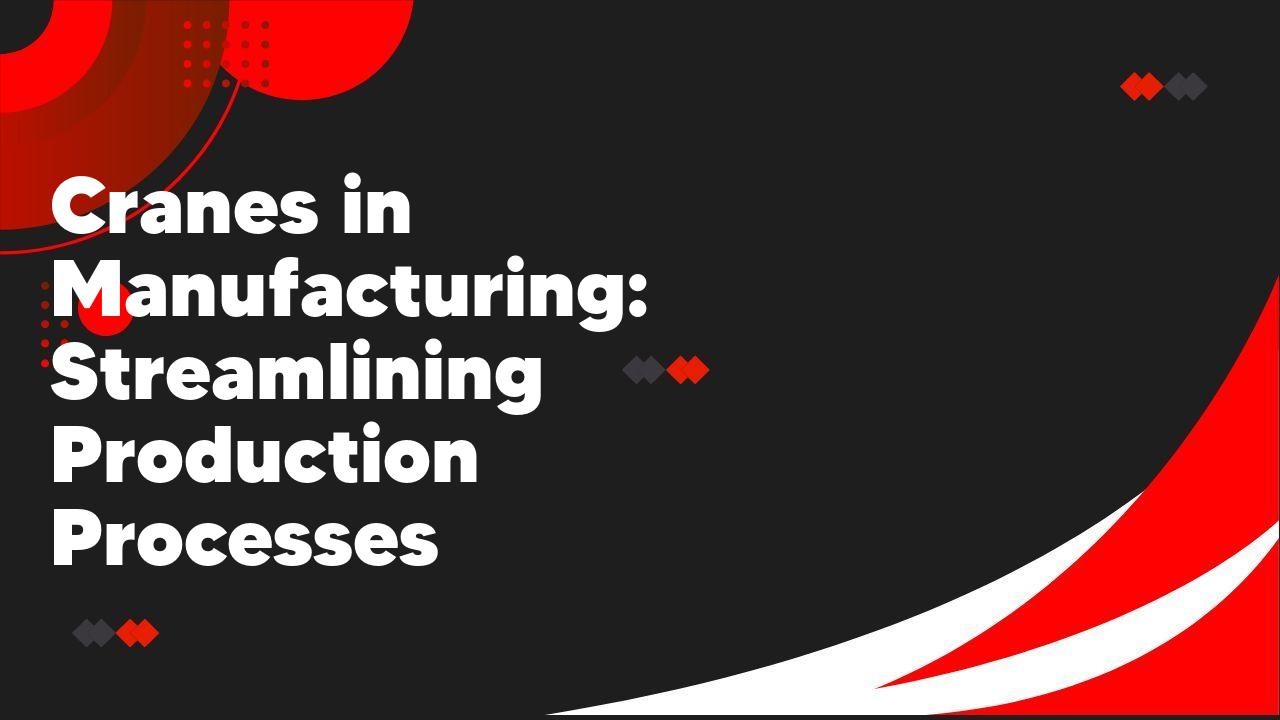In the manufacturing industry, cranes play a crucial role in streamlining production processes. These powerful machines are used to lift and move heavy materials, allowing for efficient and safe handling. From assembly lines to warehouses, cranes are essential in ensuring smooth operations and maximizing productivity.
The Role of Cranes in Manufacturing: Enhancing Efficiency and Productivity
Cranes play a crucial role in the manufacturing industry by enhancing efficiency and productivity. These powerful machines are used to lift and move heavy materials and equipment, allowing for faster and more efficient production processes. By eliminating the need for manual labor, cranes reduce the risk of injuries and accidents in the workplace. They also enable manufacturers to handle larger and heavier loads, increasing their capacity and output. Additionally, cranes provide flexibility in the manufacturing process, as they can be easily adjusted and positioned to accommodate different production needs. Overall, the use of cranes in manufacturing significantly improves efficiency, productivity, and safety.
Types of Cranes Used in Manufacturing: A Comprehensive Overview

There are several types of cranes commonly used in manufacturing processes. One of the most common types is the overhead crane, which is typically used for lifting and moving heavy loads. These cranes are mounted on a beam that is attached to the ceiling of the manufacturing facility, allowing them to move along the length of the building. Another type of crane used in manufacturing is the gantry crane, which is similar to an overhead crane but is supported by legs that run along the ground. This type of crane is often used in outdoor manufacturing environments. Other types of cranes used in manufacturing include jib cranes, which have a horizontal arm that can rotate, and mobile cranes, which are mounted on a vehicle and can be moved to different locations within a facility. Overall, the type of crane used in manufacturing depends on the specific needs and requirements of the production process.
Benefits of Using Cranes in Manufacturing: From Safety to Cost Savings
Using cranes in manufacturing offers numerous benefits, ranging from improved safety to significant cost savings. One of the primary advantages is the enhanced safety that cranes provide. By utilizing cranes, workers can avoid manual lifting and carrying heavy loads, reducing the risk of injuries and accidents. Additionally, cranes enable precise and controlled movements, minimizing the chances of damage to products or equipment. Another advantage is the increased efficiency and productivity that cranes bring to the manufacturing process. With their ability to lift and transport heavy materials quickly and effortlessly, cranes help streamline operations and save valuable time. Moreover, using cranes can lead to substantial cost savings by reducing labor costs and minimizing product damage. Overall, incorporating cranes into manufacturing operations is a wise investment that yields numerous benefits.
Streamlining Production Processes with Cranes: Case Studies and Best Practices
In this section of the article, we will explore the various ways in which cranes can streamline production processes. Through case studies and best practices, we will delve into the benefits of using cranes in different industries and how they can optimize efficiency and productivity. We will examine real-life examples of companies that have successfully implemented cranes in their production processes and the positive impact it has had on their operations. Additionally, we will provide insights into the best practices for utilizing cranes, including proper maintenance and safety protocols. By the end of this section, readers will have a comprehensive understanding of how cranes can revolutionize production processes and improve overall business performance.
Choosing the Right Crane for Your Manufacturing Facility: Factors to Consider
When it comes to choosing the right crane for your manufacturing facility, there are several factors that need to be considered. Firstly, you need to assess the weight and size of the loads that will be lifted. This will determine the lifting capacity and reach of the crane that you require. Secondly, you need to consider the layout and space available in your facility. This will determine whether you need a freestanding crane or one that can be mounted on existing structures. Additionally, you need to think about the type of crane that will best suit your needs, such as overhead cranes, gantry cranes, or jib cranes. Lastly, you need to consider your budget and the cost of maintenance and operation of the crane. By carefully considering these factors, you can choose the right crane that will optimize efficiency and safety in your manufacturing facility.
Future Trends in Crane Technology: Innovations Shaping the Manufacturing Industry
One of the future trends in crane technology that is shaping the manufacturing industry is the use of automation and robotics. With advancements in technology, cranes are becoming more intelligent and capable of performing tasks autonomously. This not only increases efficiency and productivity but also reduces the risk of human error and improves safety in the workplace. Another trend is the integration of data analytics and predictive maintenance in crane systems. By analyzing data collected from sensors and other sources, manufacturers can identify potential issues before they occur and schedule maintenance accordingly, minimizing downtime and optimizing crane performance. These innovations are revolutionizing the manufacturing industry and paving the way for a more efficient and advanced future.
Conclusion
In conclusion, cranes play a crucial role in streamlining production processes in the manufacturing industry. They enable efficient and safe movement of heavy materials, reducing the risk of accidents and injuries. By investing in high-quality cranes and ensuring proper maintenance, manufacturers can significantly improve their productivity and overall operational efficiency.
What are cranes used for in manufacturing?
Cranes are used in manufacturing to lift and move heavy materials and equipment. They are commonly used in assembly lines, warehouses, and construction sites.
What are the benefits of using cranes in manufacturing?
Using cranes in manufacturing can help streamline production processes by increasing efficiency and reducing manual labor. They can also improve workplace safety by minimizing the risk of injuries associated with heavy lifting.
What types of cranes are commonly used in manufacturing?
Common types of cranes used in manufacturing include overhead cranes, gantry cranes, jib cranes, and mobile cranes. The specific type of crane used depends on the requirements of the manufacturing process.
How do cranes in manufacturing contribute to cost savings?
Cranes in manufacturing can contribute to cost savings by reducing the time and effort required to move heavy materials and equipment. This can result in increased productivity and decreased labor costs.
What safety precautions should be taken when using cranes in manufacturing?
When using cranes in manufacturing, it is important to follow safety guidelines and regulations. This includes proper training for crane operators, regular maintenance and inspections of the cranes, and ensuring that the load capacity of the crane is not exceeded.
Can cranes be customized to meet specific manufacturing needs?
Yes, cranes can be customized to meet specific manufacturing needs. This can include modifications to the crane’s lifting capacity, reach, and control systems. Customized cranes can help optimize production processes and improve overall efficiency.
